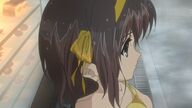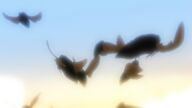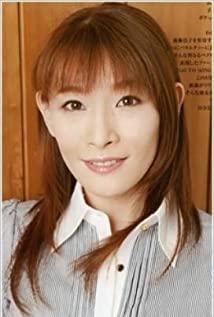Author: You Yuan
——"I am Haruhi Suzumiya from the east. I have no interest in ordinary human beings. If there are aliens, future people, visitors from other worlds, or superpowers among you, come to me, over. "
It can be said that even if ten years have passed since 2006, or even in the next ten years, no heroine's self-introduction will be more powerful, more frank, and more powerful than this sentence of Haruhi Suzumiya. . Because of such a sentence, many people began to pay attention to the special girl Suzumiya Haruhi, and pay attention to "The Melancholy of Haruhi Suzumiya".
The starting point of everything
Now light novels have become a very important source of Japanese animation adaptations, but at this time ten years ago, "light novel adaptations of animation" had just become a special category and began to flourish. And Kyoto Animation also wanted to take a share of this wave of light reforms-although they had already filmed "Full Metal Madness Campus" and "Full Metal Madness The Second Raid" before, but at that time, everyone basically didn't do much. Concerned about the light novel attributes of these two animations, Kyoto decided to make a more typical light novel adaptation animation. In the end, they took a fancy to the "Suzumiya Haruhi Series".
This series of light novels written by Tanigawa Ryu and illustrated by Ito Makura was already quite famous at the time. Tanigawa Ryu is an author deeply influenced by science fiction. Therefore, his works are more or less sci-fi, and the Haruhi Suzumiya series is no exception. Although there are settings such as "god" and "superpower" in it, it can indeed be regarded as a relatively logical science fiction novel, which is extremely rare in light novels. What's more special is that it boldly adopts the first-person perspective, showing a very interesting world through the unique and sharp complaints of the hero "Axu". The first book of this series, "The Melancholy of Haruhi Suzumiya", was published in 2003, and it won the highest award "Grand Prix" of the "SNEAKER Award" held by Kadokawa Bookstore for the Japanese light novel newcomer award-you know, Kadokawa is very proud of the "Grand Prix". "The requirements are very strict. If you think that the work does not meet the requirements, let it be absent directly. Before "The Melancholy of Haruhi Suzumiya", this award had been missing for five consecutive years. Therefore, from this award, we can also see the excellence of "The Melancholy of Haruhi Suzumiya".
But, while the original is great, that doesn't mean it's easy to animate. "Suzumiya Haruhi Series" is not like ordinary daily works, each of which is an independent unit drama, its structure can be said to be rather strange. The first volume "The Melancholy of Haruhi Suzumiya" presents a bizarre world view, and after creating the climax of the story, the second volume "The Sigh of Haruhi Suzumiya" begins to transfer to campus life, and the third volume "The Annoyance of Haruhi Suzumiya" is even more It began to turn into a collection of short stories, and just when readers thought that this book had sunk into a youthful campus comedy on the street, the fourth volume "The Disappearance of Haruhi Suzumiya" will be scattered among seemingly unrelated stories. The clues are brought together, which makes people sigh that it is a stroke of genius. From the fifth volume, it has become a collection of short stories on the youth campus, but this time, no one dares to underestimate Tanigawa Ryu. What if he comes again later to string all the clues together?
The structure of the 2006 animation
brought some difficulties to the animation of Kyoto. Prior to this, Kyoto had not produced more than one season of animation by itself, so their plan for the animation "The Melancholy of Haruhi Suzumiya" at the beginning was only one season, that is, 14 episodes. But then the problem arises. The Haruhi Suzumiya series is the most popular and the most abundant story is the "stage" from the first volume to the fourth volume. From the screenwriter's point of view, it is not too difficult to squeeze the content of four books into 14 episodes of animation, but the progress will become very tight, and it will be too wasteful - just how exciting the first volume is, It's enough to hold up a season of animation. The disappearing story can be kept for the second season in the future.
After thinking hard, Kyoto finally decided that the first season of the animation should be based on the content of the first volume of the novel, and the remaining space was filled with short stories from the following books. But then there is a new problem: the chronological order of the short stories takes place after the stories of the first volume, so they cannot be inserted into the stories of the first volume. But an animation must pay attention to the beginning and the end, and it is impossible to finish the main story in less than half of the space, and the rest should be left to daily life, right?
As a result, Kyoto came up with an unprecedented solution. That is: completely disrupt the order of TV broadcasts!
Back then, the author excitedly waited until the first episode of "The Melancholy of Haruhi Suzumiya", but when I saw the beginning, I was immediately stunned.
Shouldn't it be Axu's narcissistic narration at the beginning? Shouldn't it be the self-introduction of Haruhi Suzumiya that shocked everyone? Shouldn't it be to show her hairstyle that hasn't been the same every day for a week? Why is it "Asahina Mikuru's Adventure"? People who have read the novel can still know that this is a movie made in the story. The ordinary audience who has not read the novel is directly shocked by the lack of chroma, the camera shake, the whiteness of the reading is blunt, the special effects are 50%, in short, all the mistakes that should not be made are made. The movies that I watched over and over again scared me away... If the first episode alone can make people impressive, then the next episodes will be completely disrupted, which will be incomprehensible. mind up.
However, the seemingly chaotic playback order actually has obvious rules.
Arranging "The Adventures of Asahina Mikuru" in the first episode, this seemingly inexplicable and even nonsensical method can instantly establish a deep impression in the minds of the audience. After that, there were two main episodes, which gave the audience a general understanding of the story, but in the third episode "The Melancholy of Haruhi Suzumiya II", Nagato Yuki told Akatsuki that he was an alien, and then inserted "Haruhi Suzumiya". "The Anxiety" is a daily story, but it is a story of Yuki Nagato showing his extraordinary abilities. And in the fifth episode "The Melancholy of Haruhi Suzumiya III", I can tell you that Mikiru and Koizumi are not ordinary either... In this way, the main line and daily life are organically interspersed, and the last two episodes are naturally reserved for "The Melancholy of Haruhi Suzumiya" V" and "The Melancholy VI of Haruhi Suzumiya" to bring the entire season of animation to a close. Such a method can not only create topics, but also solve the problem of arrangement, which makes people have to write a word. So that although the order was changed back in the DVD, some people still think that it would be more interesting to watch it in the original TV broadcast order.
With this kind of clever technique, coupled with the excellent production of the animation itself, the first season of "The Melancholy of Haruhi Suzumiya" has aroused a very strong response, and it can almost be said that it has triggered an animation audience in Japan and China. a cultural boom. At that time, the Sino-Japanese animation forums were filled with posts related to Haruhi Suzumiya, which is very rare for an animation adaptation whose plot is already known. Generally, only original animations that people do not know the plot will cause this kind of situation. enthusiasm for discussion.
In the ending animation, the dance performed by the five members of the SOS group, called "group dance", also became popular on the Internet. For several years, troupe dancing has been a reserved program of China Comic Con, and many people have come into contact with troupe dance before they have even seen the animation, and then go back to look for the animation. At that time, a large number of videos imitating troupe dance appeared on video websites of various countries. Although this craze has now passed, it has become a cultural phenomenon, and its influence has remained to this day. For example, in the now popular game "League of Legends", the little white-faced ADC named Ezreal dances a group dance... The boom in animation has naturally also driven the sales of the novel version, if not for the "Magic Forbidden Book Catalog" ” and “Sword Art Online”, two rising stars, the sales volume of Haruhi Suzumiya’s novels can still remain within the top ten sales records of light novels. As for the sales of the animation itself, not to mention the average sales of 8 DVDs per volume exceeded 40,000 copies, and Kyoto would wake up laughing from a dream.
The 2009 version of animation
is such a cash cow, Kyoto will naturally not let it go. After a year, they started planning the second season. It stands to reason that the most normal way of thinking is to regard "The Disappearance of Haruhi Suzumiya" as the main content of the second season. At the beginning, Kyoto really thought so. But with the passage of time, Japan began to enter a period of substantial increase in the production of late-night animation theatrical versions, and almost no loss of profit, so Kyoto finally decided: "Disappear" and make it into a separate theatrical version!
But the problem comes again. Since the fifth volume, it is almost daily life. If you don't "disappear", the second season lacks a story that can be the mainstay, and even the length is not enough. Faced with this problem, Kyoto once again came up with a brain-opening solution: just say that we are not doing the second season, but complete the animation! As for space, it doesn't matter, there are endless August!
Everyone knows what happened next. Once again, Kyoto has adopted a special approach to publicity. First of all, I said that the replay of "The Melancholy of Haruhi Suzumiya" began in April 2009, and it was all the old animations that were adjusted back to the chronological order until the seventh episode, but in the eighth episode, a short story that had not been animated before was suddenly inserted Bamboo Leaves Rhapsody. This time, all Suzumiya fans are boiling, and Kyoto has once again achieved the effect of creating a topic.
However, they did not expect that Kyoto made almost the same eight episodes in "Endless August"!
Can you imagine how desperate the audience felt when they finally waited a week to find out that the animation was still looping endlessly in August? Kyoto is to let the audience experience for themselves how desperate it is to keep repeating the same days like Ah Xu. It's an extremely fan-favored, experimental film approach. In fact, Kyoto, which was in a transition period at the time, really did it with a mentality of experimentation and practice.
This kind of practice in Kyoto is really disgusting to many people, which is evident from the sales. Kyoto integrated the 2006 and 2009 editions of Suzumiya Animation, and released a new 8-volume DVD. The sales of the first volume were fairly normal, reaching nearly 40,000 copies, but from the beginning of the second volume, it plummeted to below 20,000, and the "Never Ending August" albums fell to the bottom. The more important problem is that many people are looking forward to the new animation of Suzumiya, just want to see "The Disappearance of Haruhi Suzumiya" appear on the screen, but after Kyoto played this hand, everyone knew that disappearing is no good. It wasn't until the last episode that the news of "The Disappearance of Haruhi Suzumiya theatrical version" came out, and everyone suddenly realized that this new animation is just advertising the theatrical version...
As an aside, I once participated in the 2006 version of the animation. The production's former Kyoto employee, Yamamoto Kan, better known as "Uncle Kan," said when asked what he thought of "Never Ending August": "They decided to do it while I was still there. Yes, but I am against it. If I hadn’t left Kyoto, this might not have happened in the end, and I feel a great responsibility for that. On behalf of the production committee, I apologize to everyone.”
Kyoto's response was: "The irrelevant people shut up!"
Fan Xiang's theatrical version
The novel version of "The Disappearance of Haruhi Suzumiya" is a very unique work. In the previous series of Haruhi Suzumiya novels, everyone revolved around Haruhi Suzumiya, and Yuki Nagato was an all-purpose character who used to help A Xu when he encountered difficulties. Except for the cute point of Sanwu, he had almost all impressions. No. In the story of "disappearance", this character was rediscovered and she was shaped into flesh and blood. It is also with this story that Nagato Yuki has become the big cute god in everyone's mind. Therefore, everyone's expectations for its theatrical version are naturally extremely high.
After the theatrical version was released on February 6, 2010, it can be said to be rave reviews. The box office of a single work of 840 million yen set a box office record for the late-night animated theatrical version at the time. Almost all fans are very satisfied with this work, because Kyoto really put a lot of effort into making it. The picture is exquisite, the performance is delicate, and in the eyes of those who like it, it can be said to be perfect. However, in the eyes of ordinary moviegoers who are not fans, a full 162 minutes of content for a novel is too long. At the beginning, the novel "The Melancholy of Haruhi Suzumiya" was made into six TV episodes, and it only took two hours to cut off the beginning and ending. This was because the rhythm of TV animation itself was relatively slow. And "The Disappearance of Haruhi Suzumiya" was made into a movie, but the rhythm was even slower. It was filled with a lot of scenes that worked hard but had limited expressiveness. Always missing that breath.
In the final analysis, this is still a fan-oriented work, and as long as most fans can buy it, they will be satisfied. Don't think it's easy to do this. Before a certain superhero movie, the general audience was dissatisfied, and most fans of the original work, even die-hard fans, sprayed it vigorously. "The Disappearance of Haruhi Suzumiya" itself is of good quality. Not only did it set a record at the box office, but the combined sales of Blu-ray and DVD reached 130,000 copies, a terrifying figure. Such an answer is enough to satisfy the investors. The animation for the series came to a perfect end.
end
Yes, it can only come to an end. Although the novels of the Haruhi Suzumiya series are not over yet, it took a full four years after the release of "The Split of Haruhi Suzumiya" in 2007 before the release of "The Consternation of Haruhi Suzumiya", and these two books still did not give the story of Haruhi Suzumiya. Draw a period. It has been almost five years since 2011, and the author Tanigawa Liu still has not written a new work. It is basically certain that the Haruhi Suzumiya series of stories has joined the team of "see you in my lifetime".
However, even if there is no finale, these 28 TV episodes and a theatrical version in Kyoto have already told a complete story. In the past ten years, I have always been the leader of my own, the big cute god with enthusiasm in the bland, the 1096 senior sister who freely switches between intellectual and natural stupidity, always the rotten spring, and the non-stop complaining all day long. Jon Smith...they have gone from ordinary characters to cultural symbols that have left a clear mark on our memories and the history of Japanese animation.
View more about The Melancholy of Haruhi Suzumiya reviews











